Four negative Covid-19 tests and 21 days of hotel quarantine – who on earth would sign up for something like this? Well, apparently me. After eight months of work and online classes back home, I recently made the decision to return to my university in Hong Kong for the spring semester.
I knew getting there wasn’t going to be easy, and so, I started planning weeks in advance. The best resource for up-to-date information when it comes to arriving in Hong Kong is the Hong Kong government’s Covid-19 thematic website. If you are planning to travel to Hong Kong, I highly recommend reading through all the available information relevant to you multiple times before you fly.
I emphasize “up-to-date information” because circumstances are constantly changing. If there is one thing I learned flying during the pandemic, it is that in addition to highly unreliable airline schedules, everchanging government/immigration rules are bound to make your travels difficult and unpredictable.
For instance, in my case, Canada, the country I was flying from, had been added to the list of high-risk countries only a few weeks before my flight, requiring me to adapt to a whole different set of procedures.
Pre-Departure Covid Test
Two days before my flight, I headed to Vancouver International Airport, not to check-in, but to get a Covid test. Departing from a high-risk country, I was required to provide a negative result no older than 72 hours.
To maximize the chances of getting my test results in time, I tried to get an appointment exactly three days before my scheduled departure time. When the phone operator told me the earliest available appointment was only 48 hours before the flight, I nearly panicked. I really couldn’t afford to miss my flight because the laboratory might have taken too long to process my test.
With few other options, I reluctantly paid the hefty fee of CA$300 that day and experienced my first nasal swab. They really are as uncomfortable as the footage on TV always shows. About 26 hours later, I received a negative result in my inbox with more than enough time to spare. And after having the lab correct a spelling error in my name, I was good to go.
At the Airport
On the day of my flight, I drove to the airport, gave my mom a big hug and walked toward the check-in counter, knowing full well that due to the pandemic, there was no telling when or where I would see my family again.
Since the pandemic began, I have experienced just how eerily empty the virus has caused airports to become, including those in Kuala Lumpur, Hong Kong or Munich. YVR was no different. With almost all of the international departures check-in area closed, I was directed to domestic check-in, where I was greeted by friendly staff. The agents were incredibly accommodating to the many requirements passengers flying this route had to comply with and even helped me print some of my documents, suggesting it would ease my journey to not have to pull up various PDFs on my phone all the time.
In addition to my negative coronavirus test, I also had to show proof of a 21-day hotel booking. Back in March 2020, when I went through Hong Kong arrival quarantine coming back from Malaysia, home isolation was still allowed and the quarantine period was only 14 days. With regulations becoming stricter by the month, travellers now had to book 21 nights at a designated quarantine hotel. Luckily, my university provided some assistance, arranging a discounted rate for students at a hotel it had partnered with. But even with the discount, HK$570 per night (incl. meals) would still add up significantly. But I guess, with tourism virtually at a standstill in Hong Kong, this arrangement is probably the only way for hotels to survive.
Having checked-in, I breezed through empty security and strolled through the once-bustling, but now empty international terminal of YVR. Oddly, the tranquillity seemed to complement the aquariums and nature-inspired First Nations theme throughout the building. After one last cup of A&W root beer and a Tim Horton’s donut, I headed to the gate, which seemed to be fenced off, with staff waiting at the entrance to once again check if passengers had all the required documents with them.

Empty terminal 
Gate agents checking passengers’ documents
When it comes to flying to Hong Kong, airlines have become increasingly careful. The previous weeks saw multiple instances of airlines around the world getting their licenses to fly to Hong Kong suspended for 14 days due to Covid-related regulatory breaches. With the flight ban not sparing large airlines such as Emirates, KLM and British Airways, Air Canada’s diligence was very much justified.
The Flight

Boeing 787-9 Dreamliner 
Nearly empty gate
This was my first flight ever where there was no line for boarding. When boarding was announced over the speakers, the few people dotted around the gate glanced up, slowly picking up their bags and one by one made their way to the empty checking desk. What a rare spectacle.
After taking my seat, I took a moment to admire the huge Dreamliner windows through which I noticed a layer of frost on the wings, sparkling in the sun. I glanced at the snow-capped mountains in front of the clear January sky and started feeling a bit sad about leaving. But I reminded myself that being in the same timezone as my professors and being around my friends would be well worth it.
Boarding was completed in no time, and soon, a flight attendant walked through the aisle distributing Covid kits, a nice gesture I have yet to experience on other airlines. In addition to a mask and hand sanitizer, the bag also included in-flight snacks and earphones.
After a quick stop at the de-icing bay, we took off and started our 14-hour journey across the pacific.

I got my first meal almost immediately after take-off, which, in coronavirus fashion, came in a cardboard box in which everything was pre-packaged. And with an airplane as empty as ours, both food and drinks services were completed in a breeze.

The remainder of the flight was largely uneventful. I did notice, however, that the crew was fairly inconsistent with their Covid-19 protections, some wearing goggles, some not, and wearing PPEs only once we’ve taken off. Nevertheless, they seemed to be sufficiently hygiene conscious and were incredibly friendly. Four movies and two more food services later, we began nearing our destination.

En route to HKG 
Very empty flight
Covid-19 Arrival Procedures
We landed just before 6 PM local time and I wouldn’t be leaving the airport until five hours later. As soon as we exited the plane, countless signs with arrows and staff pointed to where we had to go. There were a worryingly large amount of employees simply standing beside the signs and ushering us toward the various escalators, hallways and doors as if we even had anywhere else to go (the airport needs to keep people employed, I guess).
The path led us onto the airport train and then to HKG’s midfield concourse, a satellite terminal usually processing dozens if not hundreds of flights every day and bustling with activity. Now, it had been converted into what they call the Temporary Specimen Collection Centre, essentially a Covid-19 arrival hall. The building was completely transformed from the last time I had been there. There were temporary walls, fences and floors, numerous plexiglass-protected processing desks, instruction signs, and plenty of people in PPE.


Instead of boarding holidaymakers, this gate now serves as a long-term parking spot
The first sign alerted us to the different procedures we would have to follow. Essentially this consisted of the following steps:
- Complete electronic health and quarantine information declaration
- Receive an electronic tracking bracelet and connect it to a dedicated app
- Obtain quarantine order
- Complete Covid-19 test
- Wait for the test result
- Go through immigration and baggage claim

It seemed like the first few stations were exclusively dedicated to checking the QR code confirming that we completed the online health declaration. Although I had already filled out everything a day before my flight, I still couldn’t get past the many frantic airport employees donning face shields and asking me to show them my proof over and over again.
Following this, an official called my phone to make sure I gave them the correct number.
At the next stop, I was given a chunky electronic wristband, which I had to connect to an app. Apparently, the bracelet uses GPS, mobile and wi-fi signals to ensure I don’t leave my quarantine place.
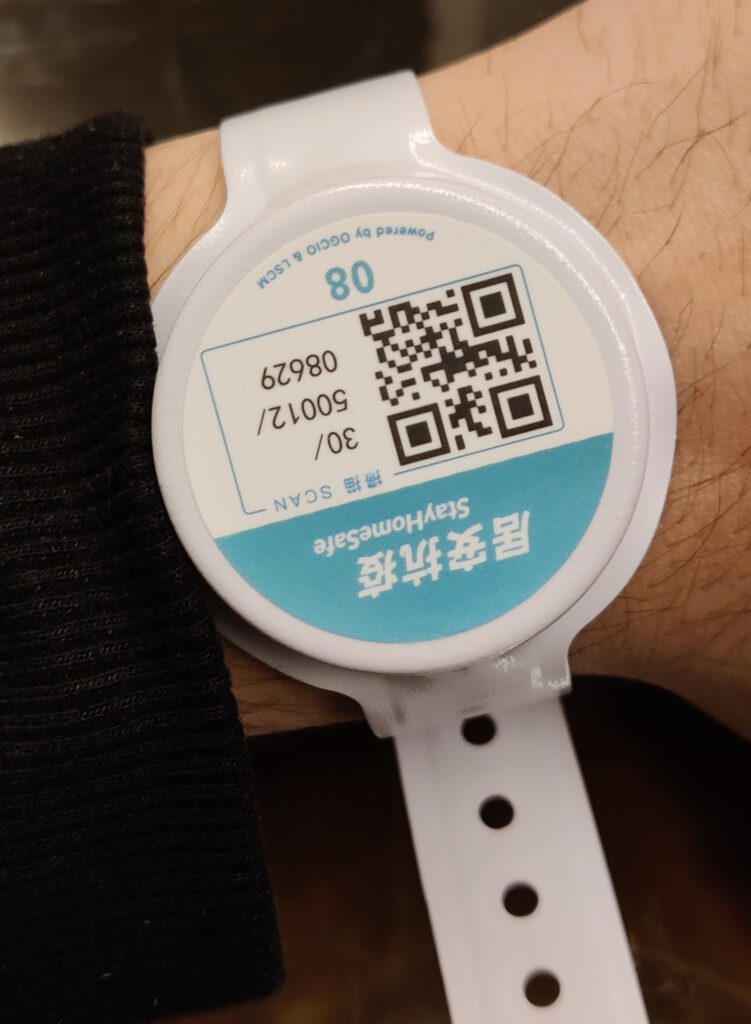
Eventually, I made it to the quarantine order desk, where a friendly man asked me to hand over my boarding pass, passport, Hong Kong ID card, negative Covid test, lab accreditation certificate and hotel booking confirmation. After recording all my information, he handed me two CuMasks (government-supplied cloth masks with trace amounts of copper), a free thermometer to check my temperature, a Covid test vial, a lanyard, a bunch of information sheets and a quarantine booklet. Lastly, I was handed my quarantine order, a document officially mandating me to 21 days in quarantine and listing the intimidating consequences of non-compliance (up to HK$25,000 and 6 months imprisonment).
Now it was time for my second Covid-19 test in three days. Standing in line, I noticed the flight attendants from my flight were also lining up. I wondered how they felt about the current situation. Did they willingly sign up for the burden of undergoing a Covid test and hotel isolation on the job? Might this have been their first intercontinental flight in a while? How many of them were worried about their job safety? I recently read that Hong Kong is set to impose a 14-day quarantine on airline crews soon, meaning that for pilots and flight attendants, these worries will probably get worse before they get any better (apparently, the change is predicted to cost airlines, especially those dependent on HKG millions of Hong Kong dollars).
I sat down in one of many little temporary testing compartments, read the instructional sheet and waited for the nurse. She came a few minutes later and efficiently stuck a pair of cotton swabs into both of my nostrils and in the back of my throat – certainly not the most comfortable of experiences.
With the bulk of the arrival procedures done, I passed my test vial to another official, who picked up the bag with a pair of tongs. At the next station, I was given a handful of free refreshments and then told to wait for my test result, which, according to them, could take between four to six hours.

Along with the fellow passengers on my flight, I was assigned a seat and table at a waiting area. I got some admin stuff out of the way, watched some YouTube videos and started getting increasingly tired. After all, it had already been more than twenty hours since I started my journey.
After just two hours and forty-five minutes, much earlier than I expected, an official came up to my desk and told me I was good to go. I got on a bus, headed back to the main terminal, and continued through immigration. After picking up my suitcases, which were neatly lined up next to the baggage belt, I followed some more signs and fences to the shuttle bus area. Staff proceeded to double-check my quarantine location and told me to stand in line number one. Because quarantine is only possible at one of a set of designated quarantine hotels, six shuttle buses drive a given route in regular intervals, bringing passengers to their respective hotels.

Hotel, at Last
When I boarded the bus, I noticed that despite us having just tested negative for the second time and sitting several feet away, the bus driver still wore a full-body protective suit, which I thought might have been a little excessive.

This idea that all arriving passengers were to be treated as infected individuals continued at the hotel, where another person clothed in PPE showed me the way to the check-in desk. After settling the bill and signing several forms, I was given some more information sheets and my room key card, which I was told, would only work once, meaning they really were serious about me staying in my room throughout the entire quarantine period.

Arriving on my floor, I was greeted by a friendly reminder that leaving my room was a serious offence.
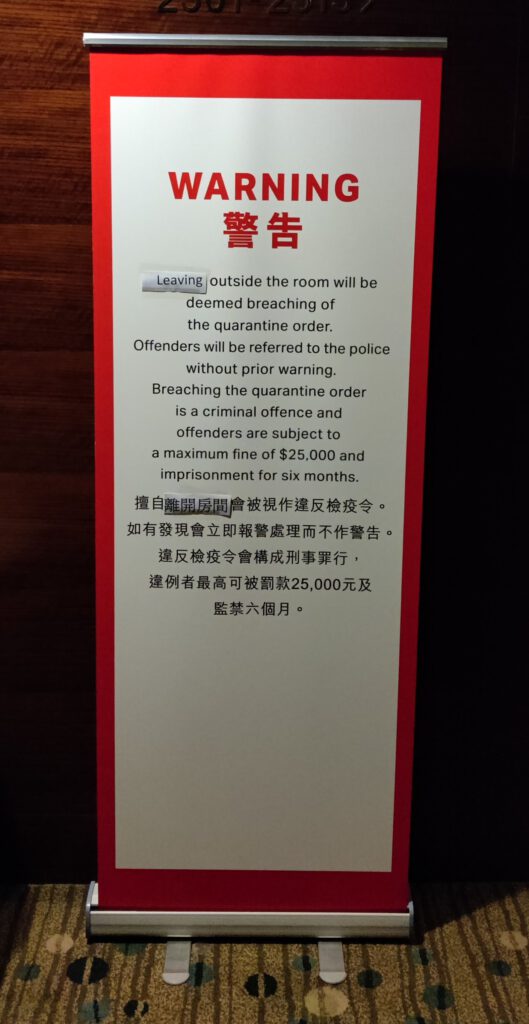
I was incredibly relieved to have finally made it into the room, but the surprises didn’t end here. To make sure I was cared for during the next three weeks, there were two boxes of bottled water, a set of spare bedsheets and a sanitation gift bag waiting for me, which included rubber gloves, toilet scrubbers, a kitchen roll, garbage bags, disinfectant spray and alcohol wipes. Welcome home!
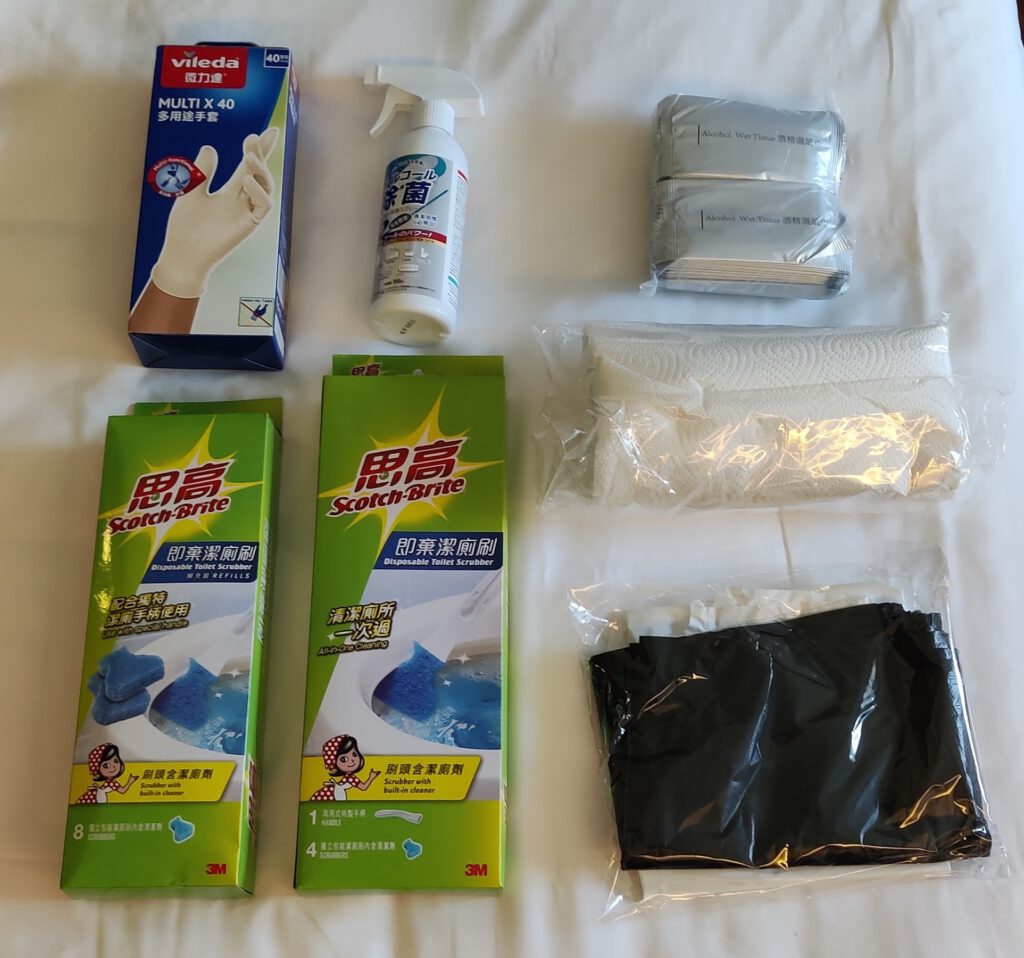
Too lazy to unpack, I fell asleep instantly that night.
Writing this post, I still have 20 nights and two more negative Covid-19 tests (on day 12 and day 19) before I will have finally reached my destination. And, while this whole thing is incredibly painful and inconvenient to go through, I have no doubt things will start looking brighter soon when it comes to travelling. I am looking forward to the days where travel will no longer be a burden, but an experience to look forward to.








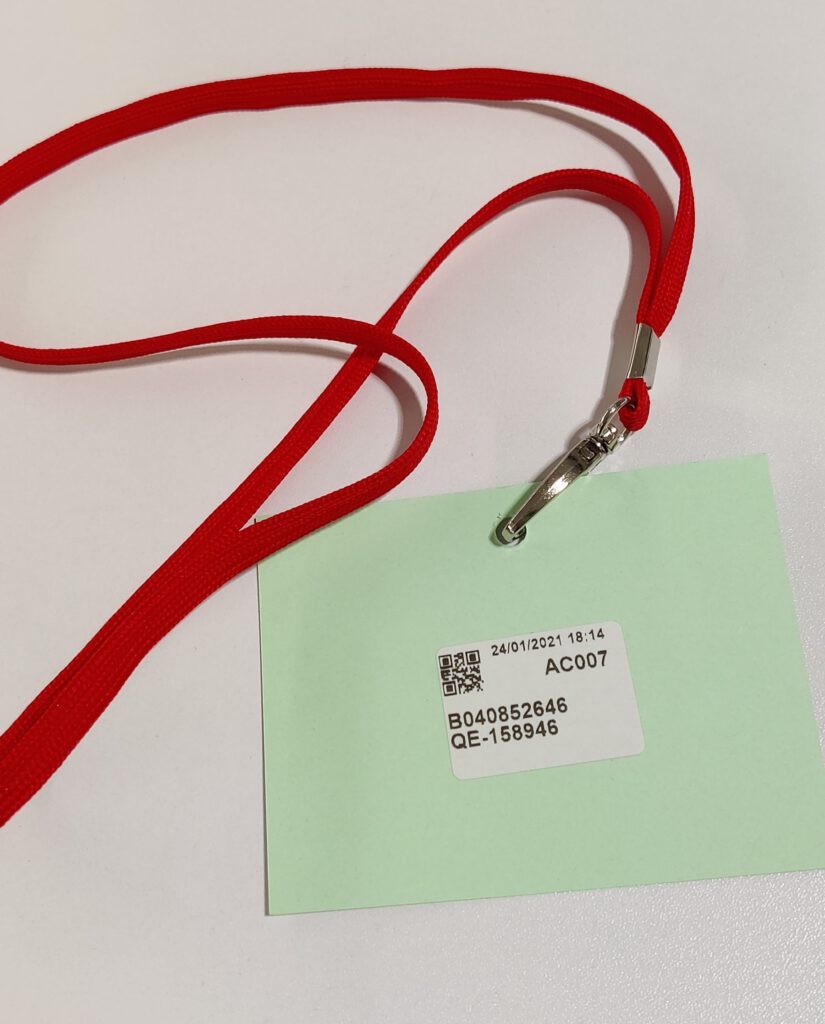

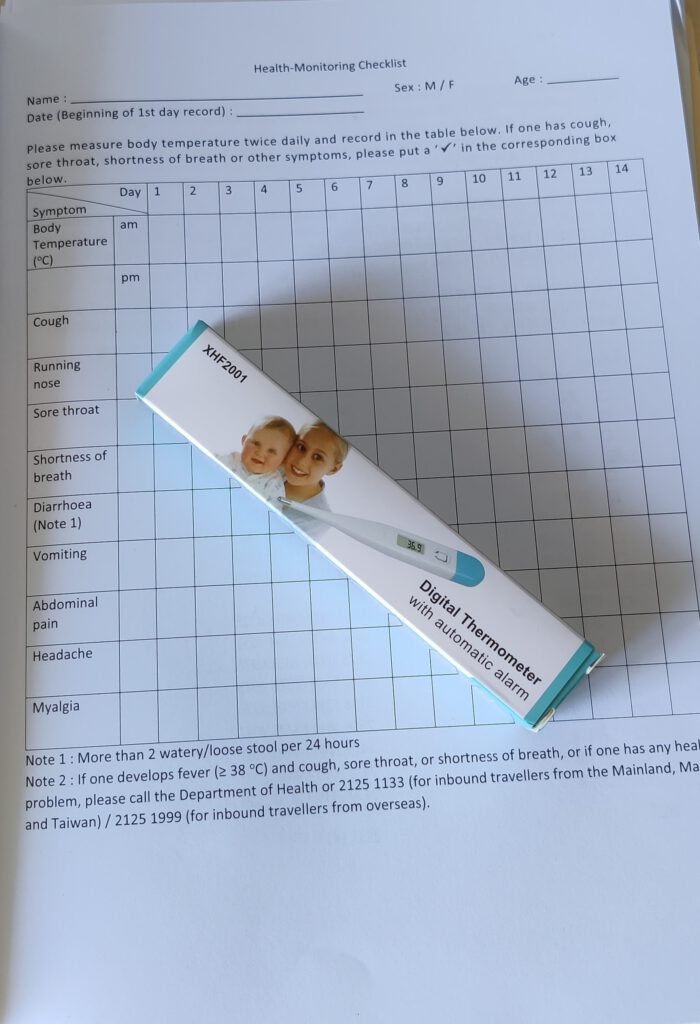




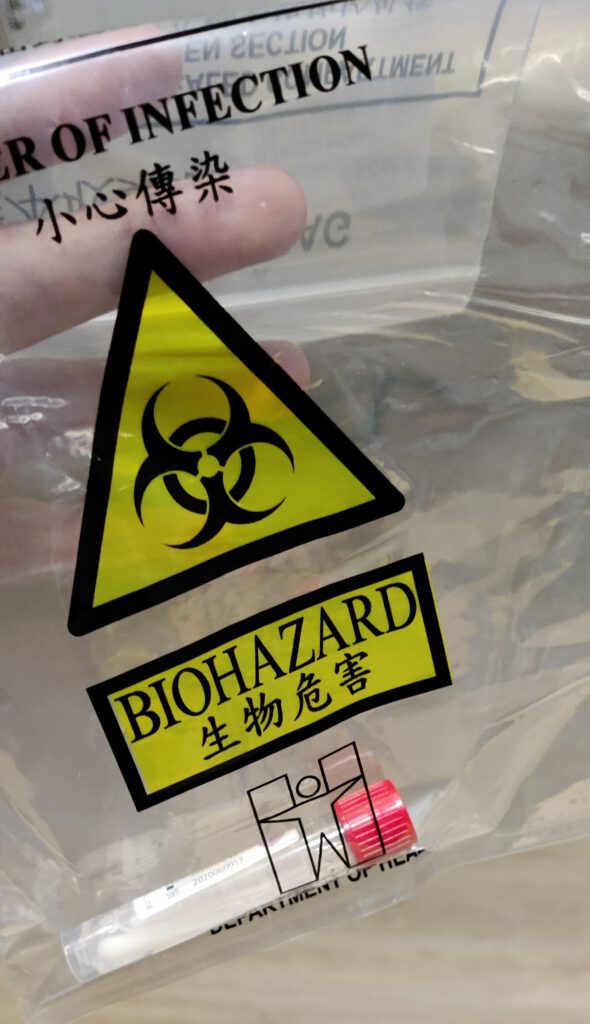

Great that you provide this detailed historical proof of these very unusual times these days.
Hope you stay well during the isolation time in your quarantine hotel.